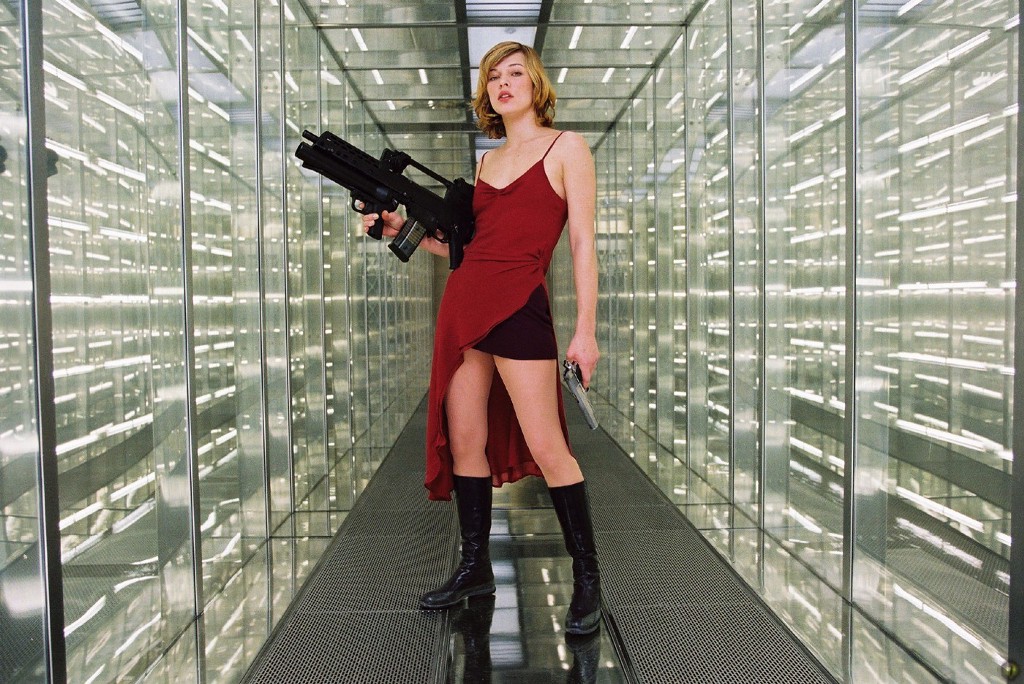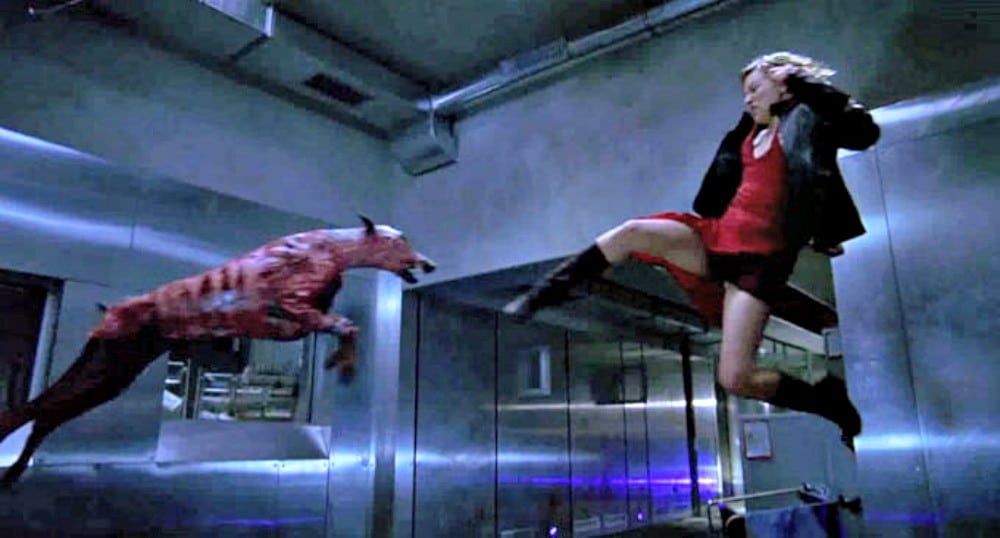We begin our look back at Paul W.S. Anderson’s series where it all began.

For most movie maniacs, January is a month of cinematic resolutions and award season catch-up. To aid in that mindset, our own Rob Hunter just started a weekly column highlighting lower profile films worthy of your attention, and will certainly aid you in launching 2017 in the right direction. However, January is also a month for bottom feeders. It’s a “Dump Month” that sees studios dropping dreck like Alone in the Dark, Bloodrayne, and In The Name of the King. Hmmmm…anyone else miss Uwe Boll? The tide may be turning as one time tent pole pictures invade the wintery months (I’m looking at you Kung Fu Panda 3 and Deadpool), but a dark part of me has always awaited the rejected SyFy Channel concepts that occupy the cinematic kickoff. These films often represent a kitchen sink attitude of desperate genre regurgitation, and there’s a real glee to be found to witnessing what sticks to the wall. For every Uwe Boll monstrosity, you get a Tremors, Smokin’ Aces, or Cloverfield. January is a parade for weirdo cinema with no aspirations for critical acclaim.
For the first time in the franchise’s history, a new and apparently final Resident Evil film will land in the dump month. Bad sign? Paul W.S. Anderson’s assault on the Umbrella Corporation is usually reserved as a post-summer, September digestive. Discharging it during January could seem like an exhaustive measure by Screen Gems to get it out of the way for the inevitable reboot, or maybe they only want those Deadpool dollars.
Frankly, I don’t care about their rationale. I love the Resident Evil films. Easily ignorable by the masses, and apparent disappointments to fans of the video games, the Resident Evil sextuplet is a hodgepodge of sci-fi horror concepts, and an unabashed showcase for Milla Jovovich. They’re the type of mid-budget genre fair that just don’t get produced in this era of shared universes and titanic spandex. Having recently suffered the dull failures of Warcraft and Assassin’s Creed, we apparently still have some time to wait before receiving a proper masterpiece of video game adaptation. Anderson’s Mortal Kombat and Resident Evil still reign supreme (although I’d hear cases for Christophe Gans’ Silent Hill and Xavier Gens’ Hitman).
As we build to the release of Resident Evil: The Final Chapter on January 27th, I want to plead my case for Paul W.S. Anderson’s apocalyptic epic. Each week, I’ll dissect a film in the series and await your disgust in the comments section. Or maybe, I may find a few acolytes of The Hive peering from the fringes.
The first Resident Evil is utterly genuine. While the film strays from the plot line, and completely ditches the characters of the original games, Resident Evil attempts to recreate the claustrophobic palpitations players found on the PlayStation. Plummeting the audience into the subbasement of The Hive, the film opens with corporate stooges falling prey to their own evil experiments. The sterile stainless steel corridors are awash in the T-Virus, a deadly mutagen that transforms these saps and their Dobermans into everyone’s favorite flesh eating zombies. Seeing these faceless drones scream into the ever-watchful eye in the sky cements their fate as eventual fodder for Milla and her army.
Jason Isaacs, doing his best John Larroquette, introduces the Amazon-like tentacles of the Umbrella Corporation via an Escape From New York voiceover. Be afraid, be very afraid, as 9 out of every 10 homes contains its products, and help feed its thirst for profits and expansion into military technology, genetic experimentation, and viral weaponry. Big brother corporate baddies are so easy to hate these days, especially when they’re constantly birthing end level boss fights.
Marrying his obsession with Lewis Carroll’s Alice In Wonderland to Raccoon City, Paul W.S. Anderson sticks his finger into the eye of fandom by replacing Resident Evil staples Chris Redfield and Jill Valentine for Milla Jovovich’s original creation. Stumbling out of the shower with amnesia, her Alice literally walks through a looking glass, and into the secret corridors of The Hive. Dragging a group S.T.A.R.S agents (that include Colin Salmon and Michelle Rodriguez) down the rabbit hole with her, Milla’s Alice must contend with The Hive’s Red Queen A.I. as well as the roving hoards of the undead. Booby traps and gnashing teeth await the team behind every corner, replicating as many jump scares from the game as possible.
It’s hard to believe in the current gorehound climate of televisions’ The Walking Dead, but the early aughts were plagued with soft R Rated horrors. One of the major flaws going against the first Resident Evil is that it’s never allowed to embrace its Romero roots. Day of the Dead homages in which S.T.A.R.S. soldiers are enveloped by zombies play out as sanitized playground escapades when they should be dripping with slippery sinew. The audience keeps waiting for the film to go redband, but is ultimately left blue balled.
Yet, there are still several sequences in this first outing worthy of a Fangoria cover spread. Early on in The Red Queen’s lockdown of The Hive, Colin Salmon’s number One maneuvers his squad down a corridor that suddenly alights with a limb slicing laser beam. A task more familiar to 8-bit gamers than fans of fixed camera styles; the laser beam transforms into mesh netting, and Cuisinarts the solider. Anderson admits on the commentary track that this is a direct tribute to Vincenzo Natali’s Cube, but it’s always fun to see a human reduced to meat chunks. So, keep those ripoffs coming!
Possibly the most memorable scene from the film (and the video games for that matter) are the viciously annoying Doberman attacks. Draped in what looks like a revolting splatter of pizza and spaghetti, the zombified Dobermans are thankfully dispatched against Alice with a practical effects makeover. Who knows what pains or displeasures these dogs had to go through to reach peak ghoulie status, but their snarling pasta snouts are one of the few wins for the video game devotees. Anderson’s fetishizing of Milla Jovovich’s red dress pays off in a big way when she’s finally allowed to launch a Street Fighter flying kick to the undead doggie.

The real reason to exalt the Resident Evil films in any real fashion is because Milla Jovovich is a fascinating watch. The first time I ever encountered her was in the wannabe 21 Jump Street, Kuffs. It’s a nothing girlfriend role for Christian Slater’s too cool for school copper, but even then, there was an ethereal quality to her cadence of performance. Obviously, she is stunningly attractive, and her directors often leer at her with an uncomfortable intensity (this leering would eventually result in a marriage to Anderson in 2009), but she inhabits this otherworldly appearance with an intimidating authority. She commits to Alice and her silly endeavors with absolute confidence in the thin plotting. She simply sells every inch of this flick.
For the first half of the movie, Milla’s Alice wanders the halls of The Hive in a daze. Who is she? Why do we care? Just when we’re at our wits end with her wilting flower routine, the memories kick back in, a badass is revealed, and she can go toe-to-toe with Michelle Rodriguez’s growling frenemy. The first Resident Evil holds back a little too long on this heroic asskicker, and just when she’s certified for ammunitions, the film hits you with a doomsday cliffhanger. The end? That’s it? But…but…but…Raccoon City!?!
If this had been the first and only Resident Evil film, I’d cry foul at this sudden revelatory halt. Secret spooky mansion basements are fun and all that, but the potential of a Thunder Dome Apocalypse is what this Dead Head dreams about. Alice, armed with a shotgun, a couple of holes drilled into her head, steps out into the desolate streets of Raccoon City ready for the end times.
Join us next week, when I dive into the sequel that sheds any pretense of quality, and goes for broke with Project: Nemesis. Paul W.S. Anderson retreats to Alien vs Predator, and 2nd unit man, Alexander Witt steps up to the feeding frenzy.
Related Topics: Action, Science Fiction

